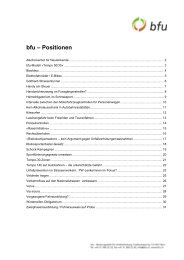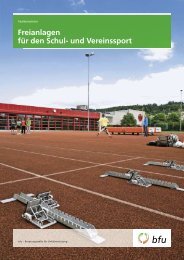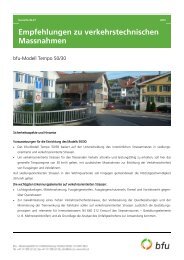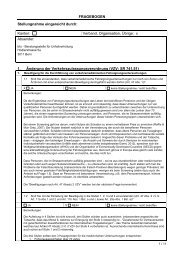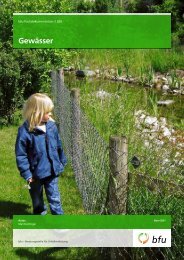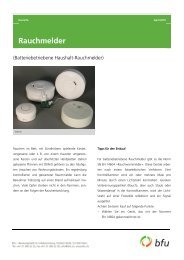Haus und Freizeit - bfu
Haus und Freizeit - bfu
Haus und Freizeit - bfu
Sie wollen auch ein ePaper? Erhöhen Sie die Reichweite Ihrer Titel.
YUMPU macht aus Druck-PDFs automatisch weboptimierte ePaper, die Google liebt.
level. Therefore, the prevention challenge should<br />
consist of maintaining or even expanding this standard<br />
in future. This challenge includes both behaviourally<br />
preventive as well as situationally preventive<br />
intervention approaches such as, for example,<br />
educational measures for children/adolescents and<br />
their supervisors and the periodic state-of-the-art<br />
servicing or maintenance of electrical equipment<br />
and systems (Table 12).<br />
4.5 Particular aspects re. prevention<br />
work<br />
4.5.1 Children and adolescents – strategic<br />
considerations<br />
The European report on the prevention of<br />
children’s injuries contains an action plan consisting<br />
of nine points, which aims to ensure that<br />
intended prevention goals can also be realised.<br />
While these considerations or recommendations<br />
refer to the European Union, they also appear to<br />
be relevant to Switzerland:<br />
1. Comprehensively integrate injury prevention for<br />
children and adolescents into the promotion of<br />
children’s and adolescents’ health and development<br />
2. Develop and implement a policy and a plan for<br />
the prevention of accidents mong children: different<br />
sectors would have to be involved (such<br />
as governmental and non-governmental institutions<br />
and organizations, the private sector, the<br />
media and the public). This policy would have<br />
to take all children into consideration, particularly<br />
those with a low socio-economic status. In<br />
addition, the policy must not only be limited to<br />
the home and leisure sector, but must also take<br />
the sports and road traffic sectors into account.<br />
3. Implement evidence-based interventions for the<br />
prevention and control of injuries among<br />
children<br />
4. Strengthen the health system to give adequate<br />
consideration to injuries among children<br />
5. Develop skills and exchange best-practice information<br />
6. Improve the quantity and quality of the data on<br />
injury-prevention among children<br />
7. Determine priorities regarding the risk factors,<br />
the effect, the cost and prevention of injuries<br />
among children and support research and evaluation<br />
8. Increase awareness and goal-oriented investment<br />
for the prevention of injuries among<br />
children<br />
9. Discuss the differences re. injuries among<br />
children<br />
4.5.2 Reflections on a new system for the<br />
analysis of accident segments<br />
The <strong>bfu</strong> system does not always match the international<br />
categorisations of accidents or injuries. This<br />
complicates any direct comparison with international<br />
data and findings. Some accident segments<br />
must be critically analyzed in terms of their thematic<br />
orientation and corresponding benefit for prevention<br />
work. This applies particularly to the accident<br />
segments «Broken glass, sheetmetal, etc.»<br />
and «Burns, chemical burns”. During the preparation<br />
of this report, it was also discovered that in<br />
comparison to international literature, the injury<br />
patterns, «Asphyxia» (including choking while<br />
swallowing) as well as «Strangulation» are not<br />
(separately) listed within the <strong>bfu</strong>’s statistics. Optimising<br />
the system of accident segments might not<br />
only contribute to refining prevention work, but<br />
<strong>bfu</strong>-Sicherheitsdossier Nr. 09 Kurzfassung / Version abrégée / Riassunto / Condensed Version 83



